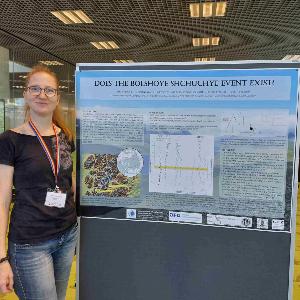Mineral magnetic and palaeomagnetic analyses of lake sediment cores
Contributions to the understanding of the Earth’s magnetic field from detailed mineral magnetic and palaeomagnetic analyses of high-resolution, high-latitude lake sediment cores
Contributions to the understanding of the Earth’s magnetic field from detailed mineral magnetic and palaeomagnetic analyses of high-resolution, high-latitude lake sediment cores
High-resolution and well-dated sedimentary records are important archives for directional and intensity variations of the Earth's magnetic field and play a key role in understanding the evolution of the Earth's magnetic field, as well as the related processes in the Earth's deep interior. In this regard, the uneven distribution of palaeomagnetic data across the globe is a critical issue. In particular, a higher data density is desirable in the Arctic, as most of this region lies in the tangent cylinder of the inner core, where the geodynamic activity is expected to be different compared to outside. In this project, the relative palaeointensity (RPI) and palaeosecular variation (PSV) will be reconstructed for three sites in the Arctic, located inside and outside the tangential cylinder. Analyses will be conducted on high-resolution sediment cores from Lakes Bolshoye Shchuchye (506-48, 506-50, Co1321), Maloye Shchuchye (506-51) and Levinson-Lessing (Co1401), that were previously analysed in terms of regional climate and environmental history, and have well constrained chronologies. Core Co1401 has an age of ~62 ka at the base, while cores 506-X and Co1321 reach ages of ~24 ka and ~27 ka, respectively. Initial work on core Co1401 from Levinson-Lessing Lake has shown that the record is excellent for palaeomagnetic analysis and consistently contains magnetofossils. Furthermore, the core Co1401 recorded the geomagnetic excursion Laschamps and Mono Lake in unprecedented high-resolution for the Arctic. However, the RPI of the upper part of core Co1401 was shown to be compromised by initial greigite formation. Preliminary palaeomagnetic analyses of cores from lakes Bolshoye Shchuchye and Maloye Shchuchye revealed a directional anomaly around 20 ka, but further palaeomagnetic evidence necessary for interpretation is lacking. To improve RPI and PSV reconstructions for the Arctic, detailed investigations will be carried out to a) characterise the mineral magnetic carriers b) determine the concentration and diversity variations of magnetofossils and c) analyse the influence of greigite on the palaeomagnetic record. Furthermore, the new RPI and PSV data will be statistically analysed and included in new geomagnetic field models, which make use of a global compilation of published palaeomagnetic data and will facilitate a better understanding of the field geometry. Based on these findings, the following overarching goals will be tackled: A) It will be show if the geodynamo activity in the tangent cylinder is different from the pattern of activity outside. B) Spherical harmonic models will test if the directional anomaly recognised at ~20 ka is connected to a geomagnetic excursion (e.g., Hilina Pali). C) The influence of the geomagnetic field intensity on the abundance of magnetofossils will be investigated for the first time. D) The effect of variable concentrations of freshwater magnetofossil on RPI determinations will be determined.

Geomagnetic field excursions are a revealing curiosity of the Earth's magnetic field